Three - Nathens, Siegel
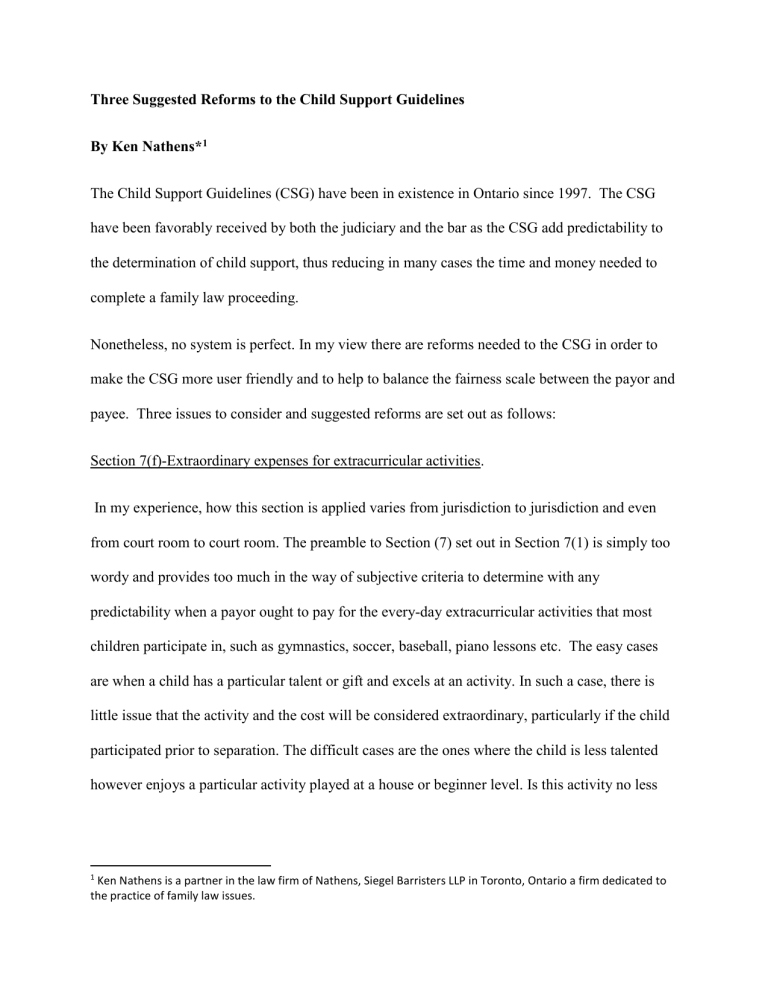
Three Suggested Reforms to the Child Support Guidelines
By Ken Nathens* 1
The Child Support Guidelines (CSG) have been in existence in Ontario since 1997. The CSG have been favorably received by both the judiciary and the bar as the CSG add predictability to the determination of child support, thus reducing in many cases the time and money needed to complete a family law proceeding.
Nonetheless, no system is perfect. In my view there are reforms needed to the CSG in order to make the CSG more user friendly and to help to balance the fairness scale between the payor and payee. Three issues to consider and suggested reforms are set out as follows:
Section 7(f)-Extraordinary expenses for extracurricular activities.
In my experience, how this section is applied varies from jurisdiction to jurisdiction and even from court room to court room. The preamble to Section (7) set out in Section 7(1) is simply too wordy and provides too much in the way of subjective criteria to determine with any predictability when a payor ought to pay for the every-day extracurricular activities that most children participate in, such as gymnastics, soccer, baseball, piano lessons etc. The easy cases are when a child has a particular talent or gift and excels at an activity. In such a case, there is little issue that the activity and the cost will be considered extraordinary, particularly if the child participated prior to separation. The difficult cases are the ones where the child is less talented however enjoys a particular activity played at a house or beginner level. Is this activity no less
1 Ken Nathens is a partner in the law firm of Nathens, Siegel Barristers LLP in Toronto, Ontario a firm dedicated to the practice of family law issues.
extraordinary because the child is of average ability and not gifted? In my view section 7(f) may discriminate against children of average ability.
A more objective standard is required to determine whether an expense paid for an extracurricular activity is extraordinary, other than if the expense is a “necessity in relation to the child’s best interests and the reasonableness of the expense in relation to the means of the parents or spouses and those of the child and the spending pattern of the parents or spouses in respect of the child during cohabitation.”
The standard I propose is one that fixes a percentage of the table amount of child support that must be allocated to extracurricular activities by the recipient before any further activities may be considered to be extraordinary. I suggest that the recipient of child support be required to pay up to 10% of the table amount of child support on extracurricular activities for children prior to being entitled to claim that any further extracurricular activities constitute an extraordinary expense.
For instance, if a mother receives $1000.00 per month in child support, or $12,000.00 per annum, it is reasonable to expect that $1200.00 per annum should be paid for the children’s activities. Only after 10% of the table amount is paid out for activities by the recipient, will it be open whether any further activities for a child will considered to be “extraordinary” pursuant to section 7.
The advantages of this percentage based approach are:
(i) There will be no argument whether activities are extraordinary or not until the minimum threshold of 10% of table child support is paid by the recipient. This will reduce litigation and the endless arguments about whether Timmy’s tee ball is an extraordinary expense
and subject to re-apportionment. The legal and stress cost of the argument is far more than the cost of the tee ball.
(ii) The dollar amount to be paid by a recipient for activities will be dependent on the amount of child support received. A mother who receives $5000.00 in table child support monthly will be expected to contribute far more to the extracurricular activities of the children on her own than a mother who receives $500.00 monthly in child support.
Therefore, the percentage approach incorporates the parties’ incomes and living standards in determining whether an extracurricular activity truly is extraordinary for that particular family.
Of course no system is fool proof. In situations where there are additional section 7 expenses incurred for the children as a matter of necessity, such as private school, braces, tutoring, child care etc, the 10% threshold may be high as the recipient is already paying towards other section 7 expenses for the children. In this case adjustments may be made that will take into account the other section 7 expenses already being paid and reduce the 10% threshold accordingly. The exact calculations and adjustments may be subject to further research and another paper, another day.
Section 3-Support for Adult Children:
Section 3 as now written leads to much uncertainty regarding the length of time that a parent has to pay child support for an adult child. Some cases are clear. In cases where the child is not able to withdraw from parental control due to illness or handicap then there is no issue that child support should extend beyond the age of 18.
The problem lies with the more common situation, the child who is a perpetual student or is “sort of” in post-secondary studies, but not applying himself or herself to the school program or is content to have one or more “gap” years prior to completing studies thus extending the child support obligation. There is too much litigation on the issue of when child support should stop for an adult child. The problem lies not only with section 3 of the CSG but also with the definition of “child under section 2 of the
Divorce Act and section 31 of the Family Law Act that stipulates that “every parent has an obligation to provide support for his or her unmarried child who is a minor, or is enrolled in a full time program of education, to the extent that the parent is capable of doing so.”
It is not fair that child support payors many of whom are of modest mean, are not able to plan their financial futures as his or her (mostly his) child support obligations are indefinite. To remedy this unfortunate flaw in section 3 of the Child Support Guidelines (as well as the definitions of child under the Divorce Act and the FLA) I recommend that section 3 of the Child
Support Guidelines be amended to provide a rebuttable presumption that child support terminates
(a) once a child reaches the age of 18, and is no longer enrolled in school full time, or (b) when the child reaches the age of 22 if that child remains in a full time education program past the age of 18 and applies himself or herself in a manner commensurate with his or her academic potential. In order to be entitled to child support, the child over the age of 18 must provide to the payor evidence as to his or her on going academic progress and regular attendance to be entitled to continued child support.
If a recipient parent seeks child support for a child over the age of 22, he or she shall be required to seek the consent of the payor parent to continue supporting the child until the age of 24. If no consent is given, the recipient parent may commence a court application to require that the payor continue to pay support until the age of 24, on the condition that the young adult over the age of
22 continues in a full time education program and provides the payor with evidence of academic enrolment and progress.
The payment of child support for a young adult over the age of 22 will be the exception and not the rule. It will be dependent on the payor’s financial means, nature of the relationship between payor and child, evidence of outstanding academic achievement, and proof being provided of attainable goals for the young adult to become self- sufficient on completion of the program.
After the age of 24 all child support obligations, including section 7 obligations, shall be terminated. Any financial assistance provided to a person over the age of 24 shall be voluntary only, as would be the case if the young adult lived in an intact family as opposed to a separated one.
This proposed amendment recognizes that at a certain point child support is no longer the right of a child but a privilege for diligent work efforts and a commitment to academics. No longer will support recipients be able to hold on for as long as possible to child support when the child is not making serious efforts to attend in post-secondary studies or refuses to provide school grades and attendance records to the payor parent. It further recognizes that a 22 year old is no longer a
“child of the marriage” even if in school full time, and has responsibility to pay for his or her own studies or as required, fund his and her own education.
Section 7 of the Child Support Guidelines must also be amended to apply the same age limits regarding the obligation to contribute to a young adult’s post-secondary education studies.
Section 9: Shared Custody and 40% Rule:
Of all the CSG sections that require reform this is the one most in need of a major overhaul. This section is flawed not only as a result of the 40% physical custody threshold being arbitrary and there being no one objective standard to determine when a parent has “physical custody of a child not less than 40 per cent of the time over the course of the year” but also because this section emphasizes the importance of quantity of parenting time over the quality of the parenting.
Two examples emphasize this point:
Example A: Father “A” has his children 42% of the time. He has the children 42% of the time as he told Mother “A” that he would take her to court and make her life miserable if he did not have the children more than 40% of the time because he does not want to pay the full table amount of child support. Father “A” is seldom around the home when the children are with him, leaves the children to make frozen pizza most nights, and does not buy them any clothes as he says that he already pays child support (albeit at a reduced rate) and therefore Mother “A” must buy all the clothes. The children share a bedroom in his home and seldom do their homework when in his care, as he does not see the importance of school work.
Example “B”: Father “B” has the children every second weekend and one overnight during the week. This represents approximately 35% physical custody of the children. When Father “B” has the children with him he goes to Whole Foods to purchase only the finest for them. He buys their clothes because he feels that Mother “B” does not provide the children with proper clothes and he does not want to see his children being dressed by Sam Walton. He lives in a place he can accommodation he can barely afford so that the children each have their own bed room where they do their homework with him. Unfortunately, as a result of his work schedule that requires frequent travel he is not able to spend more time with the children that he already does. Father
“B” Skypes the children daily when he is not with them physically. He has purchased blackberries for each of the children so they can always reach him if needed.
Given the wording of section 9 of the CSG, Father “A” may not have to pay the full table amount of child support as he has physical custody of the children more than 40% of the time.
Father “B” does have to pay the full amount as he has physical custody less than 40% of the time. In my view, this creates a systematic flaw where the less devoted father may be rewarded financially while the more devoted father is not.
There is no easy fix to the CSG’ emphasis on quantity of parenting time and not quality.
However, apart from the 40% threshold in section 9, there should also be room for some subjectivity on the part of judiciary to determine that a parent has “shared parenting” although enjoying physical custody less than 40 % of the time. Some criteria to determine when this may be the case include the following:
(a) The access parent having sufficient residential accommodations for the children during access time including proper overnight accommodations.
There is no real difference between a primary caregiver requiring a three bedroom condo and an access parent having to maintain a similar condo for when the children visit.
(b) The access parent having a vehicle suitable for the children for access visits, such as the access parent buying a mini-van to accommodate the children’s car pools, ski and hockey equipment.
(c) The access parent dedicating no less than 50% of his or her food budget to the children.
(d) The access parent altering his or her work schedule to accommodate the children’s activities or needs. This may include taking the children to medical or dental appointments during access or non-access time, attending at parent teacher interviews, filling in when the primary care parent is not able to look after the children etc.
(e) The access parent enjoying vacations with the children similar in time and duration to those enjoyed by the primary care parent.
The danger of a subjective approach to shared parenting is that the CSG become less predictable to apply and there will be many parents that will argue that they “share custody” even though they have the children less than 40% of the time. This will lead to more clogged courts, not less.
Case law will have to develop over time that provides what criteria will be deemed to be most important in determining whether an access parent shares custody although having the children less than 40% of the time.
The CSG has a formula as to when a parent would suffer “undue hardship” if required to pay the table amount of child support (Section 10 of the CSG). There is no reason why a formula cannot be established to assist in determining when a less than 40% access parent may be considered a shared custody parent for the purposes of the payment of child support and therefore entitled to a reduction of the amounts set out in the tables in consideration of the financial and emotional support he or she provides directly to the children.
It will be difficult to apply the subjective approach to shared parenting at first instance as it will take time to determine whether an access parent has what it takes to be a “non 40% of the time shared custody parent” and thus entitled to get a break on the table amount of child support. It may take a year or two after the initial separation and parenting plan is put into place to properly determine the role that the access parent plays in the life of the children and the costs that he incurs for them apart from the child support paid.
Change is necessary notwithstanding the difficulties in re-focusing Section 9 of the CSG on quality of parenting and not quantity of parenting. As it stands now, the less than 40% access parent (typically the father) is often seen both in society at large and by the judiciary as a
“wallet” who does not share the same emotional bond and commitment to his children as does the primary care parent. This creates two separate and unequal classes of parents. In my view this has impact on the ability for the access parent to properly parent the child and how the child and access parent view one another. This has long lasting emotional impact that extends beyond financial need and ability to pay.


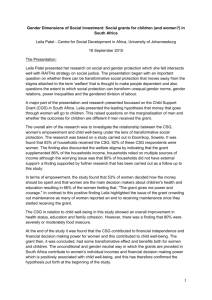
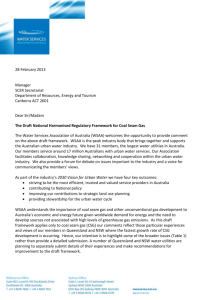
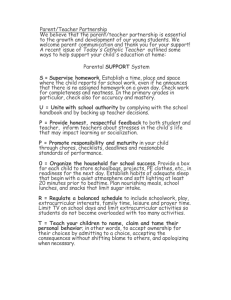


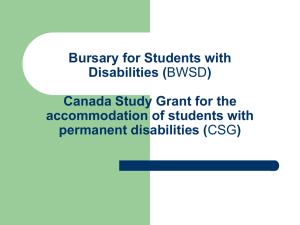
![Educational Setting – Offer of FAPE [IEP7B] English](http://s3.studylib.net/store/data/006809815_1-704b6bcef8e9a29f73a2206ea1b6ed19-300x300.png)